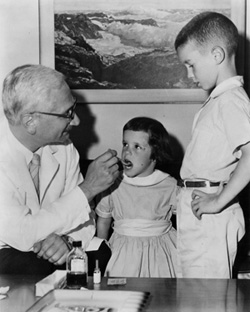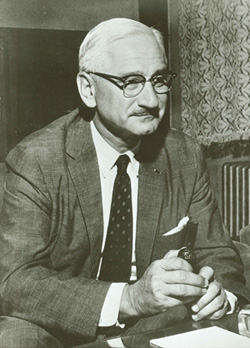 The University of Cincinnati Libraries have completed a three-year project to digitize the correspondence and photographs of Albert B. Sabin, developer of the oral polio vaccine and distinguished service professor at the University of Cincinnati’s College of Medicine and Children’s Hospital Research Foundation from 1939-1969.
The University of Cincinnati Libraries have completed a three-year project to digitize the correspondence and photographs of Albert B. Sabin, developer of the oral polio vaccine and distinguished service professor at the University of Cincinnati’s College of Medicine and Children’s Hospital Research Foundation from 1939-1969.
The collection is freely and publicly available via the Albert B. Sabin website at http://sabin.uc.edu/ and includes approximately 35,000 letters and accompanying documents totaling 50,000 pages of correspondence between Sabin and political, cultural, social, and scientific leaders around the world. Also included are nearly 1,000 photographs documenting the events and activities worldwide that were part of Sabin’s crusade to eradicate polio.
“This is what every biographer dreams of – so easy to use and complete,” said Charlotte Jacobs, MD, emerita professor of medicine at Stanford University and an accomplished biographer.
The project, funded by a grant from the National Endowment for the Humanities, is a “We the People” initiative designed to encourage and strengthen the teaching, study, and understanding of American history and culture through the support of projects that explore significant events and themes in our nation’s history and culture and that advance knowledge of the principles that define America.
The Sabin digitized correspondence and photographs are of great relevance to the research efforts of historians, social and political scientists, ethicists, biomedical researchers, and physicians, as well as students and scholars worldwide. Marguerite Rose Jimenez, a postdoctoral fellow at American University researching Sabin and his polio eradication efforts in the Americas, commented, “[T]he archives just keep getting better and better! The search functions and thoroughness of the searches generated is really amazing and so incredibly helpful! I’ve found all sorts of things using key search terms that I never would have found searching through the documents as hard copies.”
 The correspondence and photographs are part of the Hauck Center for the Albert B. Sabin Archives. Sabin’s wife, Heloisa, donated his papers, medals, and other artifacts to the University of Cincinnati upon his death in 1993. They reside in the Henry R. Winkler Center for the History of the Health Professions where they have been organized and preserved with the support of the John Hauck Foundation.
The correspondence and photographs are part of the Hauck Center for the Albert B. Sabin Archives. Sabin’s wife, Heloisa, donated his papers, medals, and other artifacts to the University of Cincinnati upon his death in 1993. They reside in the Henry R. Winkler Center for the History of the Health Professions where they have been organized and preserved with the support of the John Hauck Foundation.
In addition to providing easy access to the 50,000 pages of digitized correspondence and photos, the Albert B. Sabin website includes a biography and timeline of Sabin’s life and career, a section about the vaccination program referred to as “Sabin Sundays,” and information about the complete Sabin Collection, which encompasses 400 linear feet and consists of correspondence, laboratory notebooks, manuscripts, photographs, audio and video recordings, and other research papers generated by Sabin during his long and active medical career from 1930-1993. Also included on the website are lessons plans created to encourage high school teachers to use the Sabin digital collection in their classrooms.
For more on the Hauck Center for the Albert B. Sabin Archives and the digitization of the correspondence and photographs, contact the Winkler Center at (513) 558-5120 or by e-mail at chhp@uc.edu. In addition, a blog was kept by Stephanie Bricking, Sabin archivist, as she worked on the collection. The blog, available at www.libraries.uc.edu/liblog/topics/albert-b-sabin-archives/, provides insight into Sabin’s life and accomplishments. Stephen Marine, UC Libraries’ associate dean for special collections and the project’s principle investigator, adds that the blog is also, “a gold mine of potential research topics for medical historians, historical epidemiologists, medical ethicists, historians of the Cold War, public health officials, and many others.”
